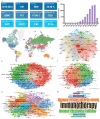Uncovering the flip side of immune checkpoint inhibitors: a comprehensive review of immune-related adverse events and predictive biomarkers
- PMID: 38169638
- PMCID: PMC10758091
- DOI: 10.7150/ijbs.89376
Uncovering the flip side of immune checkpoint inhibitors: a comprehensive review of immune-related adverse events and predictive biomarkers
Abstract
Immune checkpoint inhibitors (ICIs) have generated considerable excitement as a novel class of immunotherapeutic agents due to their remarkable efficacy in treating various types of cancer. However, the widespread use of ICIs has brought about a number of safety concerns, especially the development of immune-related adverse events (irAEs). These serious complications could result in treatment discontinuation and even life-threatening consequences, making it critical to identify high-risk groups and predictive markers of irAEs before initiating therapy. To this end, the current article examines several potential predictive markers of irAEs in important organs affected by ICIs. While retrospective studies have yielded some promising results, limitations such as small sample sizes, variable patient populations, and specific cancer types and ICIs studied make it difficult to generalize the findings. Therefore, prospective cohort studies and real-world investigations are needed to validate the potential of different biomarkers in predicting irAEs risk. Overall, identifying predictive markers of irAEs is a crucial step towards improving patient safety and enhancing the management of irAEs. With ongoing research efforts, it is hoped that more accurate and reliable biomarkers will be identified and incorporated into clinical practice to guide treatment decisions and prevent the development of irAEs in susceptible patients.
Keywords: Cancer; Immune Checkpoint Inhibitors; Immune-Related Adverse Effects; Immunotherapy; Markers.
© The author(s).
Conflict of interest statement
Competing Interests: The authors have declared that no competing interest exists.
Figures




Similar articles
-
[Predictive Biomarkers of Immune-related Adverse Events Induced by Checkpoint Inhibitors in Malignancies].Zhongguo Yi Xue Ke Xue Yuan Xue Bao. 2020 Dec 30;42(6):825-830. doi: 10.3881/j.issn.1000-503X.11534. Zhongguo Yi Xue Ke Xue Yuan Xue Bao. 2020. PMID: 33423733 Review. Chinese.
-
New biomarkers exploration and nomogram construction of prognostic and immune-related adverse events of advanced non-small cell lung cancer patients receiving immune checkpoint inhibitors.Respir Res. 2023 Feb 27;24(1):64. doi: 10.1186/s12931-023-02370-0. Respir Res. 2023. PMID: 36849947 Free PMC article.
-
Immune-Related Adverse Events as Clinical Biomarkers in Patients with Metastatic Renal Cell Carcinoma Treated with Immune Checkpoint Inhibitors.Oncologist. 2021 Oct;26(10):e1742-e1750. doi: 10.1002/onco.13868. Epub 2021 Jul 8. Oncologist. 2021. PMID: 34156726 Free PMC article.
-
Immune-Related Adverse Events by Immune Checkpoint Inhibitors Significantly Predict Durable Efficacy Even in Responders with Advanced Non-Small Cell Lung Cancer.Oncologist. 2020 Apr;25(4):e679-e683. doi: 10.1634/theoncologist.2019-0299. Epub 2019 Nov 19. Oncologist. 2020. PMID: 32297443 Free PMC article.
-
The biomarkers related to immune related adverse events caused by immune checkpoint inhibitors.J Exp Clin Cancer Res. 2020 Dec 14;39(1):284. doi: 10.1186/s13046-020-01749-x. J Exp Clin Cancer Res. 2020. PMID: 33317597 Free PMC article. Review.
Cited by
-
The possible and intriguing relationship between bullous pemphigoid and melanoma: speculations on significance and clinical relevance.Front Immunol. 2024 Aug 29;15:1416473. doi: 10.3389/fimmu.2024.1416473. eCollection 2024. Front Immunol. 2024. PMID: 39267741 Free PMC article. Review.
-
Immunotherapy for advanced-stage squamous cell lung cancer: the state of the art and outstanding questions.Nat Rev Clin Oncol. 2025 Mar;22(3):200-214. doi: 10.1038/s41571-024-00979-8. Epub 2025 Jan 6. Nat Rev Clin Oncol. 2025. PMID: 39762577 Review.
-
Association between platelet-to-lymphocyte ratio and immune checkpoint inhibitor-induced thyroid dysfunction.Endocrine. 2025 May;88(2):491-500. doi: 10.1007/s12020-025-04164-4. Epub 2025 Jan 22. Endocrine. 2025. PMID: 39838195
-
Optimizing Cancer Treatment Through Gut Microbiome Modulation.Cancers (Basel). 2025 Apr 7;17(7):1252. doi: 10.3390/cancers17071252. Cancers (Basel). 2025. PMID: 40227841 Free PMC article. Review.
-
Scleroderma-like Lesions in a Patient Undergoing Combined Pembrolizumab and Routine Chemotherapy: A Case Report and Literature Review.Medicina (Kaunas). 2024 Jul 3;60(7):1092. doi: 10.3390/medicina60071092. Medicina (Kaunas). 2024. PMID: 39064521 Free PMC article. Review.
References
-
- Dunn GP, Bruce AT, Ikeda H, Old LJ, Schreiber RD. Cancer immunoediting: from immunosurveillance to tumor escape. Nature immunology. 2002;3:991–8. - PubMed
-
- Chen DS, Mellman I. Oncology meets immunology: the cancer-immunity cycle. Immunity. 2013;39:1–10. - PubMed
-
- Postow MA, Sidlow R, Hellmann MD. Immune-Related Adverse Events Associated with Immune Checkpoint Blockade. The New England journal of medicine. 2018;378:158–68. - PubMed
-
- Kennedy LB, Salama AKS. A review of cancer immunotherapy toxicity. CA: a cancer journal for clinicians. 2020;70:86–104. - PubMed
Publication types
MeSH terms
Substances
LinkOut - more resources
Full Text Sources
Medical

